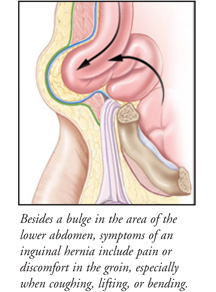 A Bulge Through the Abdominal Wall
A Bulge Through the Abdominal Wall
A hernia is a bulging of connective tissue (fascia) through a weak area or tear in the wall of muscle that holds the intestines in place. Although there are several types of hernias, the most common hernia is an inguinal hernia, an intestinal bulge through the abdominal wall muscle in the groin area.
Inguinal hernias are about 10 times more common in men than women, and the risk is higher in people who are obese, are chronically constipated, or have a constant cough. A small inguinal hernia may not cause symptoms. More commonly, the patient notices heaviness or pain in the groin area, especially when lifting a heavy object, straining, or coughing. A bulging out of the hernia can often be seen.
Although patients with an inguinal hernia can usually push the bulging tissue back through the muscle wall, most inguinal hernias eventually require treatment with a minor surgical procedure to avoid future
herniation of the intestinal tissue. If a segment of the intestines pushes through the muscle wall and becomes “strangled,” that is, the blood supply to the tissue is cut off, that part of the intestinal tissue can
die. This situation is a medical emergency, requiring immediate surgical repair. If the herniated tissue cannot be pushed back behind the muscle wall, symptoms of nausea and vomiting develop, or the hernia becomes dark red or purple, it is necessary to seek immediate medical attention.
Surgery Is the Most Common Treatment for Hernia
It is estimated that each year, five million Americans develop hernias, but less than one million undergo hernia repair surgery. Although hernia repair was once a major surgical procedure, modern techniques mean that in almost all cases, this surgery is done on an outpatient basis. The surgery itself usually lasts about one hour, and the patient is allowed to go home a few hours later. Return to everyday activities after surgery is often within a week or so, with certain activities restricted for a month or six weeks. During the procedure, the surgeon repositions the herniated intestine behind the abdominal muscle wall and closes the tear or weak area in the wall to keep the intestine in place. It can be performed by using a small incision (open repair) or by laparoscope (a minimally invasive instrument). In general, hernia surgery is a very successful procedure with few risks.
Causes:
Inguinal hernias can be present at birth, especially in boys, if the abdominal muscle wall does not develop correctly. The hernia can often be seen while the infant or small child is coughing, crying,
or straining during a bowel movement. Hernias that develop during adulthood may be a result of the muscle weakness that accompanies aging. Hernias are made worse with heavy lifting, constant cough-
ing, or straining on the toilet. As a result, such factors as smoking, bronchitis, or chronic constipation increase the risk of inguinal hernias.
Symptoms:
An inguinal hernia may not cause noticeable symptoms and may only be discovered during a routine physical exam of the abdomen. In most cases, however, these hernias are obvious when
standing up straight, coughing, or straining while lifting or going to the bathroom. The most common symptoms are a bulging out of an area of the lower abdomen, accompanied by pain or a feeling
of heaviness in the groin area. More Common in Men: Males of all ages are at higher risk than females for inguinal hernias, but family history also puts a person at greater risk. Any condition that causes a chronic cough, such as smoking, bronchitis, or cystic fibrosis, increases the chance of inguinal hernias. Frequent straining during urination or bowel movements is another risk factor, as are increased weight and pregnancy, which increase the pressure on the abdominal wall muscles. Jobs that require significant lifting can also increase the risk of hernia development.
Surgery and Treatment:
Once an inguinal hernia is discovered, it is usually corrected surgically unless it is very small and not causing symptoms. There are two types of hernia operations—herniorrhaphy (traditional open surgery) and hernioplasty (laparoscopic repair in which a mesh “patch” covers the area). If a bulging hernia can be felt in the lower abdomen, it can often be gently pushed back behind the abdominal muscle wall while the patient is lying down. Hernias that cannot be pushed back in place can result in strangulation of the intestinal tissue, a serious complication that can be life-threatening. OTC analgesics can be used to ease discomfort before and after surgery.
Prevention:
Hernias may be prevented by avoiding strain on the abdominal muscle tissue. Lifestyle changes such as avoiding the strain of heavy lifting, maintaining a healthy weight, eating a diet rich in fiber to avoid constipation, and smoking cessation to prevent a chronic cough are all ways to help prevent the development of hernias. Most doctors do not recommend the use of truss supports to treat
inguinal hernias; if support is needed to prevent a hernia from bulging, surgery is the best solution.





